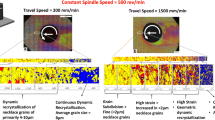Abstract
This research investigates the relationship between the microstructures of thermomechanically affected zone (TMAZ) and heat input in friction stir welding (FSW) of 5086 aluminum alloy. First, welding heat input has been predicted using a three-dimensional finite element analysis; then, welding experiments have been carried out on annealed and work-hardened conditions to study the developed microstructures and the mechanical properties of the welded metal. The results show that the temperature field in the FSW process is asymmetrically distributed with respect to the welding line. Also, both experimental and predicted data illustrates that peak temperatures are higher on the advancing side than the retreating side. In addition, the microstructures are strongly affected by the heat input, while the grain size within the TMAZ decreases with decreasing heat input per unit length during FSW.
Similar content being viewed by others
References
Thomas WM, Nicholas ED, Needham JC, Murch MG, Templesmith P, Dawes CJ (1991) Friction stir welding, international patent application No.PCT/GB92102203 and Great Britain patent application No. 9125978.8
Salem HG, Reynolds AP, Lyons JS (2002) Microstructure and retention of superplasticity of friction stir welded superplastic 2095 sheet. Scr Mater 46:337–342
Nicholas ED, Thomas WM (1998) A review of friction processes for aerospace applications. Int J Mater Prod Technol 13:45–55
Tang W, Guo X, McClure J, Murr L (1998) Heat input and temperature distribution in friction stir welding. J Mater Process Manuf Sci 7:163–172
Chao Y, Qi X, Tang W (2003) Heat transfer in friction stir welding-experimental and numerical studies. Transactions of the ASME 125:138–145
Cao G, Kou S (2005) Friction stir welding of 2219 aluminum: behavior of θ(Al2 Cu) particles. Weld J 84(1):1s–8s
Dickerson TL, Przydatek J (2003) Fatigue of friction stir welds in aluminum alloys that contain root flaws. Int J Fatigue 25:1399–1409
Guerra M, Schmidt C, McClure JC, Murr LE, Nunes AC (2003) Flow patterns during friction stir welding. Mater Charact 49:95–101
Li Y, Murr LE, McClure JC (1999) Solid state flow visualization in the friction stir welding of 2024 Al to 6061 Al. Scr Mater 40:1041–1046
Colligan K (1999) Material flow behavior during friction stir welding of aluminum. Suppl Weld J 78:229–237
Sutton MA, Yang B, Reynolds AP, Taylor R (2002) Microstructural studies of friction stir welds in 2024-T3 aluminum. Mater Sci Eng A 323:160–166
Askari A, Silling S, London B, Mahoney M (2001) Modeling and analysis of friction stir welding processes. In: Jata KV, Mahoney MW, Mishra RS, Lienert TJ (eds) Friction stir welding and processing. The Minerals Metals and Materials Society, Warrendale, pp 43–54
Zhao H (2005) Friction stir welding (FSW) simulation using an arbitrary Lagrangian-Eulerian (ALE) moving mesh approach, PhD Dissertation, West Virginia University, West Virginia
Colegrove P, Shercliff H (2003) 2-Dimensional CFD modeling of flow round profiled FSW tooling. In: Jata KV, Mahoney MW, Mishra RS, Lienert TJ (eds) Friction stir welding and processing. The Minerals Metals and Materials Society, Warrendale, pp 13–21
Hyoe T, Colegrove P, Shercliff H (2003) Thermal and microstructure modeling in thick plate aluminum alloy 7075 friction stir welds. In: Jata KV, Mahoney MW, Mishra RS, Lienert TJ (eds) Friction stir welding and processing. The Minerals Metals and Materials Society, Warrendale, pp 33–41
Schmidt H, Hattel J (2005) A local model for the thermo-mechanical conditions in friction stir welding. Model Simul Mater Sci Eng 13:77–93
Nandan R, Roy G, Debroy T (2006) Numerical simulation of three dimensional heat transfer and plastic flow during friction stir welding. Metall Mater Trans A 37:1247–1259
Ulysse P (2002) Three-dimensional modeling of the friction stir welding process. Int J Mach Tools Manuf 42:1549–1557
Song M, Kovacevic R (2003) Thermal modeling of friction stir welding in a moving coordinate system and its validation. Int J Mach Tools Manuf 43:605–615
Chao Y, Qi X (1998) Thermal and thermo-mechanical modeling of friction stir welding of aluminum alloy 6061-T6. J Mater Process Manuf Sci 7:215–233
Xu SW, Deng XM, Reynolds AP, Seidel TU (2001) Finite element simulation of material flow in friction stir welding. Sci Technol Weld Joining 6:191–193
Dunne F, Petrinic N (2007) Introduction to computational plasticity. Oxford University Press, Oxford, pp 89–90
Awang M (2007) Simulation of friction stir spot welding (FSSW) process: study of friction phenomena, PhD Thesis, West Virginia University, West Virginia
Hibbit, Karlsson and Sorensen Inc. (2004) Abaqus/Explicit user's manual, version 6.5. Abaqus Inc., Pawtucket
Prasad YVRK, Sasidhara S (1997) Hot working guide: a compendium of processing maps. ASM International, Materials Park, pp 101–103
Zhang Z, Zhang HW (2009) Numerical studies on controlling of process parameters in friction stir welding. J Mater Process Technol 209(1):241–270
Buffa G, Hua J, Shivpuri R, Fratini L (2006) Design of the friction stir welding tool using the continuum based FEM model. Mater Sci Eng A 419:381–388
Zhang Z, Zhang HW (2009) Numerical studies on the effect of transverse speed in friction stir welding. Mater Des 30(3):900–907
Sato YS, Kurihara Y, Park SHC, Kokawa H, Tsuji N (2004) Friction stir welding of ultrafine grained Al alloy 1100 produced by accumulative roll-bonding. Scr Mater 50:57–60
Cho JH, Boyce DE, Dawson PR (2005) Modeling strain hardening and texture evolution in friction stir welding of stainless steel. Mater Sci Eng A 398:146–163
Dieter GE (1976) Mechanical metallurgy. McGraw-Hill, New York
Author information
Authors and Affiliations
Corresponding author
Rights and permissions
About this article
Cite this article
Aval, H.J., Serajzadeh, S. & Kokabi, A.H. Theoretical and experimental investigation into friction stir welding of AA 5086. Int J Adv Manuf Technol 52, 531–544 (2011). https://doi.org/10.1007/s00170-010-2752-x
Received:
Accepted:
Published:
Issue Date:
DOI: https://doi.org/10.1007/s00170-010-2752-x




